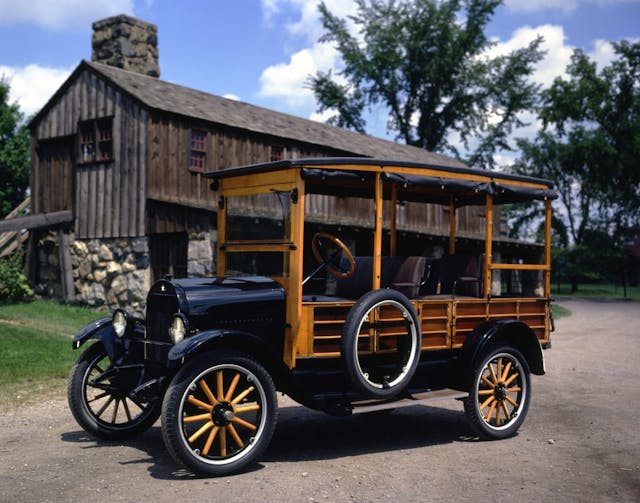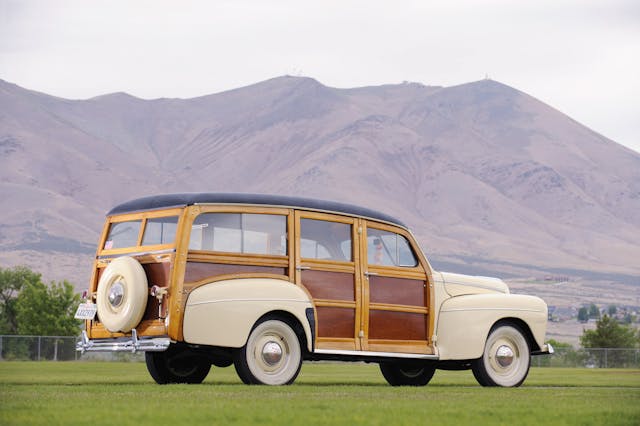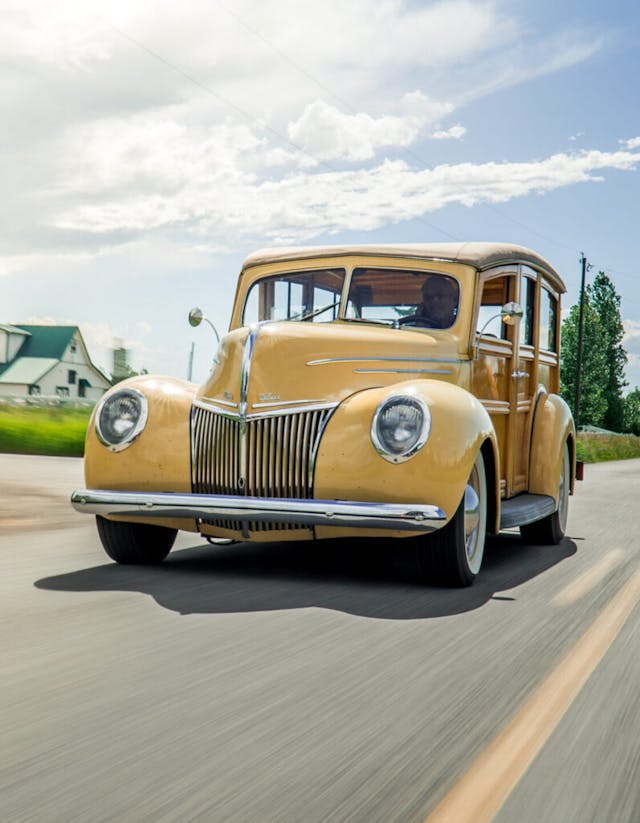A century on, wood-sided cars are still stylin’
Many of the world’s earliest automakers evolved from companies in the carriage business, and in those early days, automobiles perpetuated the proven wood-framed tradition of their forebears.
It was an obvious choice for the fledgling industry, given the low production volumes of early cars and the limited capability of contemporary metal fabrication. This was particularly true for early commercial vehicles, which were essentially an engine mated to a frame with a bare-bones superstructure (if it had one at all).
But as the amount of railroad trackage approached 400,000 route miles in 1916, the need to transfer goods (and increasingly passengers) to and from stations became more important. The vehicles that performed this labor were called depot hacks, later known as station wagons.
A Ford for your future
With the introduction of the Model T in 1908 and the subsequent revolution in personal transportation it created, it was only natural that Ford became the primary source of these important commercial vehicles.
Initially, however, Ford sold just a chassis with buyers either building their own upper body or ordering one from a local builder. Yet even though Ford didn’t supply its own truck bodies, the unceasing demand for the Model T in the late teens compelled Ford to buy its own 313,000-acre forest near Iron Mountain in Michigan’s Upper Peninsula.
Soon Ford’s sawmills yielded 375,000 board feet a day for use in the firm’s automobiles, giving it a tremendous cost and supply advantage when it came to wood body construction.

By this time, mainstream automobile body design had started to move away from wood, however, due to a maturing industrial base that could now stamp large metal panels and weld them together without the need for wood support. Yet the demand for (or the appeal of) a body that flaunted its wood construction prevailed, eventually becoming a mainstream passenger-car body style.
The first such station wagon to be offered in a carmaker’s catalog was the 1923 Star Four, manufactured by Star Motors of Elizabeth, New Jersey, one of several car brands created by Billy Durant, a cofounder of General Motors. By 1929, Ford followed suit, introducing its own factory-built, wood-bodied Model A station wagon; by 1931, the company had assembled more than 11,000 of them.

Upward mobility
Though the station wagon was listed in Star’s literature, its bodies were farmed out to the Martin-Parry Corporation in York, Pennsylvania, a practice followed by many volume producers simply because of the complex construction and high labor demands required to build wooden bodies.
Interestingly, Martin-Parry’s advertising highlighted the growing shift of station wagons from functional vehicles to lifestyle enablers. A 1927 brochure offered three variants of a “Country Club” model, pictured alongside a golfer and his caddy. The refined wooden body was “just the thing for country club, country estate, hotel, or resort service. Your guests bound from the station with their luggage or headed to the country club for a round of golf will find the body comfortable as a pleasure car.” It was a prescient view of emerging cultural changes.
Despite the decreasing use of wood in body construction, cars well into the 1930s didn’t have full metal roofs. Instead, a major portion of the roof was filled with a fragile insert composed of hardwood, wire mesh, fabric, seals, and paint that did little for structural integrity while creating squeaks and leaks as it moved around.
All that changed in 1932 when Inland Steel of East Chicago, Indiana, installed its first 76-inch-wide rolling mill. For the 1935 model year, General Motors introduced the all-steel “Turret Top,” which was quieter, tighter, far stronger—and ultimately faster and cheaper to build than the old wood-based design. Other automakers followed as soon as they had access to the stamping capability.

The introduction of the all-steel body meant that wood was nearly eliminated from body construction. At the same time, despite the economic ravages of the Great Depression, the growing suburbanization of America saw the rather primitive upright wooden station wagon transition into a more urbane and carlike vehicle.
Wood paneling evolved, just as Martin-Parry had envisioned, into a symbol of a sophisticated, affluent lifestyle. Typical was the 1935 Ford Model 48 V-8 station wagon, which now featured roll-up windows instead of side curtains. “Designed for a great variety of tasks,” a brochure proclaimed. “Desired for style as much as utility.” But that style came at a premium: At nearly $700, Ford’s woody was the most expensive body style in the lineup and just 4500 were sold.
As America entered World War II, Ford’s dominance in the woody business was significantly challenged by Chrysler and its brilliantly named “Town & Country,” introduced in 1941. Together with woody bodies offered on the Packard 110 and the Buick Super, wealthy buyers were going picnicking, no matter what was happening overseas.

The reckoning
For the first few years after the war, prewar models remained in production, but they were quickly upstaged by all-new, more forward-looking designs—and woodies were an unfortunate casualty. When Packard introduced its all-new 1948 models, its quirky “station sedan” was basically a steel body to which wood panels were attached, with the rear gate the only assembly fully made from wood.
The following year, with the introduction of the “New Generation” Ford, the amount of timber used in the station wagons was cut by about 85 percent, making the 1948 Fords the last to use structural wood. Instead, the 1949 wagons employed mahogany-skinned panels and maple framing over sheetmetal. A year later, the mahogany paneling itself was gone, replaced with Di-Noc plastic vinyl sheeting. Chrysler had been using this trimming idea on its Town & Country models since 1948, but then dropped Di-Noc and converted over to body-color panels with wood framing in mid-1949.
The end of the woody was imminent. The last true American woodies, which by then carried only a vestige of real wood, were the 1953 Buick Super Estate wagon and the 1953 Buick Roadmaster.

The woodies’ high manual-labor requirements and significant material costs were ultimately their undoing. By late 1939, for example, Ford was assembling the 1940 station wagon using 445 board feet of lumber including gum or mahogany for paneling, birch and maple for framing, and basswood for the inner roof slats. Then, the Rouge plant in Dearborn shipped to Iron Mountain 25 boxcars a day containing the required steel parts. The assembly of each wagon required different 167 sizes and shapes of wood, from long stringers to tiny framing blocks. The bodies also required a further 750 different parts, from screws to safety glass.
After this painstaking assembly step, wagons were then sent to the varnishing booth for the first coat, which, when dry, was then sanded and re-varnished twice more. It was an extraordinary amount of manual effort for a relatively modest price premium versus a sedan.
Knockoff wood
Though the “wood” in woodies might have disappeared by the early 1950s, their upmarket appeal prevailed—if only in the customer’s imagination. Some manufacturers created what were called “tin woodies,” with painted-on, wood-emulating trim. The Nash Rambler wagon, for example, had small areas of its upper body adorned with painted wood; Chevrolet did something similar, though its tacked-on framing panels gave it a slightly more credible appearance.
The tin woodies presaged the applied woodgrain trim later made famous by the Ford Country Squire, which maintained a whiff of exclusivity when a 1964 example transported James Bond to Auric Goldfinger’s Virginia stud farm in the film Goldfinger. Though far simpler than its forebears, its name as well as its trimming signaled a refined and upscale lifestyle. Other automakers responded similarly in the 1960s (and later), but none could match Ford for style—even when it was simulated style.
Chrysler went one step worse, trying to revive the magic of not one but three storied names (LeBaron, Town & Country, and Mark Cross) with the 1983 to 1986 K-car LeBaron Town & Country convertible. Advertisements featuring Ricardo Montalbán were headlined, “They are like no other cars in America, Europe and Japan.” And that was unquestionably true.

Today, classic woodies of the Golden Era just before and after the war command eye-watering prices at auction, routinely selling far in excess of their steel-bodied counterparts. Some are perfectly restored—where bringing the wood back to its original condition is a monumental task, both from a construction and an appearance perspective—while others are preserved as slightly customized, 1950s-style, surfboard-sporting beach transports.
One of the latter is a season-special maize yellow 1939 Ford owned by Tom Cotter of The Barn Find Hunter YouTube channel. He upgraded the vehicle with a GM LS crate engine and modern transmission, given how much mileage it covers as he crisscrosses the country in search of the next big discovery. For Tom, his special Ford transports him back to a youth in Long Island, New York, that was filled with hot rods, surfing, and parties at the beach.
“There’s just something about a woody that’s unlike other cars,” he says. “People admire it as much for what it is as a car as for what it is as a piece of hand craftsmanship, like fine furniture. You just don’t find that with other cars.”

Woodies is one of 20 classes to be featured at the 2023 Greenwich Concours d’Elegance, on June 2–4, 2023. Download the 2023 Greenwich Concours d’Elegance event program to learn more about Sunday’s other featured classes, Saturday’s Concours de Sport, our judges, sponsors, non-profit partners, 2022 winners and more!
***
Check out the Hagerty Media homepage so you don’t miss a single story, or better yet, bookmark it. To get our best stories delivered right to your inbox, subscribe to our newsletters.



I like real wood trimmed wagons but the vinyl “wood” never did it for me. It always looked fake. At that point I want it painted body color.
FORD woodies in ’49, ’50’ and ’51 were wood panels and framing attached to a stamped steel “skeleton”. All built on the same body with minor trim/grille changes each year.
Interesting article, thanks, Lowell. But in the third paragraph of your opening, you might be using kilometers rather than miles, because peak US railroad trackage reached 254,000 miles in 1917. It held steady through 1930, after which the Depression reduced it 16,000 in the ’30s, then down to 224,000 in 1950, despite none of our resources more pivotal toward Allied victory than the railroads.
Sadly, and stupidly, our railroads were taxed at higher rates than their subsidized competition: federally-funded super highways, the new lock systems, U.S. Army engineered and improved inland and coastal waterways, and both federal and state government-financed building of city airports. Shortsighted considering you can move 200 times the weight with the same horsepower with steel wheels on steel rails than pneumatic tires over paved road.
Other than the dire need to curb overpopulation, any environmentalist today embraces rail travel over grinding the life out of a beloved collector car on a halting lockstep over a concrete conveyor belt past miles of tire shops, Jiffy Lubes and junk food outlets.
By 2000, total US rail trackage was only 144,500, what it was in the mid-1880s. A resurgence in heavy freight traffic over more efficient routing left us with only 93,150 miles in 2020.
Ironic given that the earliest woodies were called “depot hacks,” and like the use of leather for auto upholstery, far from upscale orgins.
Where’s Jan and Dean? I got a ’34 wagon and we call it a woody…
I have a pretty nice ‘87 Country square. Yes it gets comments today
Squire!!!
Are you sure? Maybe you had it right the first time — lol…
Bert Farnham owned a business inherited from his father: Making custom wooden coachwork for fine cars beginning in the late 1920s. The company started as a furniture wood shop in in early 1900s in Boston. Bert told the tale that a potential Duesenberg owner wanted wood highlights on his new car. The owner knew of Farnham and their craftsmanship. Duesenberg built the chassis in Indiana, shipped it to Boston, Farnham added their magic, and the client’s “Woodie” was finally ready to roll.
Farnham was approached by GM, Ford, and Chrysler and had long-standing contracts supplying 400 custom chassis a year. The firm employed more than a hundred artisans. Bert apprenticed there before his first decade. By the mid-1950s, however, the business died. Bert kept memorabilia like sales brochures, blueprints, newspaper articles, and dozens of B&W pictures. He knew how to spin a yarn and at age 12 or 13. I loved it. My family lived next door in a Boston suburb and often had Yankee pot roast for supper compliments of Yancy, Bert’s wife.
Postscript: Duesenberg not only built classic automobiles but also built classic archives and documentation. I’ve tried different approaches in recent years to verify Bert’s assertions but have not yet found the right connection. In the meantime I’ll trust Bert.
It looks like there is at least record of one Farnham (and Nelson) bodied Duesenberg: https://www.prewarcar.com/397258-1917-locomobile-model-48-dual-cowl-sportif-body-by-farnham-nelson
The contracts with other manufacturers would be a lot harder to track down, but Duesenberg cars are extremely well researched and documented.
I have a 62 Ford Country Squire and a rare 63 Ford Country Squire with factory bucket seats and center console. They may have fake wood but I love these big beasts and they are rarely seen at car shows. I believe a fair number of these big Ford woodies (1961-1964) died in demolish-in derby’s in the 70’s
Interesting sidelight about Ford’s wood production at Iron Mountain. Faced with all the scraps left over from milling all those wood body parts, thrifty Henry turned ’em into charcoal, and marketed it in bags as Kingsford Charcoal for the then-emerging backyard barbecuing craze. Then the charcoal was actual wood chunks, not the pressed briquettes we get today.
The smallest woody wagons were those built by American Bantam in the late 1930s. Overseas, Fiat offered a wood-bodied Topolino woody from 1948 to 1951. Morris Minor woodies (wood framed but aluminum paneled) were built as late as 1967.
Lowell, As a member of the board of directors of the National Woodie Club, I found this to be an excellent article. With your permission, we may like to reprint it in our National Woodie Times.
Please let me know if you would give us permission.
Thanks for the feedback! As for reprinting, I’d suggest you contact Hagerty directly for that.
A late 1970s Mercury Colony Park wagon roared into our family for a while in the early 1980s (with my mother’s second husband). What a monster of a car (kind of like its owner), a rhapsody of dark brown leather club seating and big block bodaciousness. And of course, it had acres of plastic woodgrain stuck to it. It looked ridiculous, but also somehow fitting for the titanic genre… Thanks for the history, the details, and for the trip down memory lane.
My father had a 47 Pontiac woody with a little amber indian heading the hood, little bulb in it, I think. I had a late 80’s minivan with wood style plastic appliqué (contact paper where I’m from). My wife cried when we had to replace it and they had discontinued the woody look. “Made it look like a truck without it” her words circa 1990.
I’ve got a ’51 Buick Super woodie I’ve owned since 1978. Been restored since 1984. Always draws looks & thumbs up where ever I take it. All my old cars have some sort of wood trim in the interior. ’32 Ford hi boy hot rod, ’49 Buick convert, ’56 Tbird, & a ’57 Ranchero
I may yet make my next WilFord WagCo a woody. Looks great- last one was a 53/94, I built an oak “kitchen” for it, but I didn’t exposed any wood to the exterior. Please you keep up the great work too.
Your text information is incorrect that the 1935 Ford V8 Woodie Station Wagon had roll-up windows. The rear windows were celluloid and could be rolled up into the roof inside. In 1936 and 1937 it became an extra cost option, again fitted with side curtains. Glass windows became standard in 1938 and Ford made hydraulic brakes standard equipment in 1939.